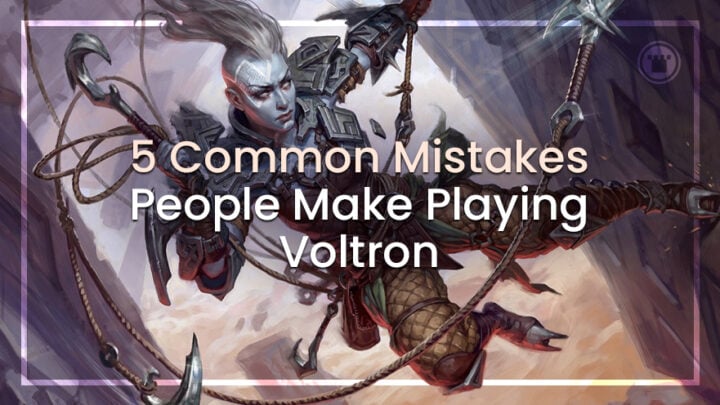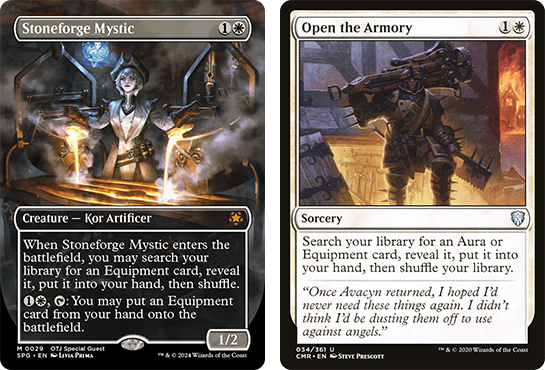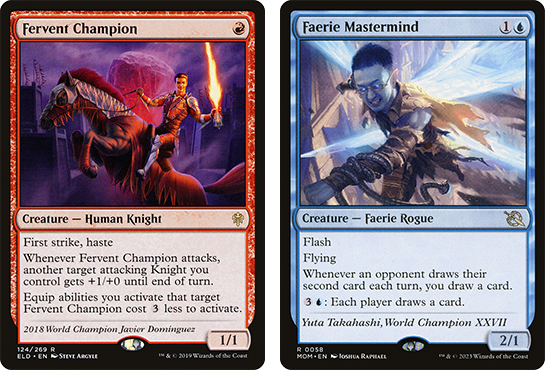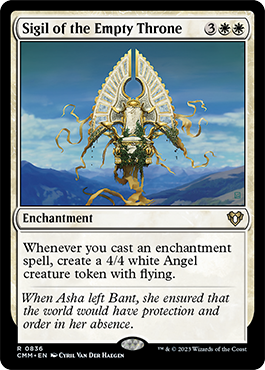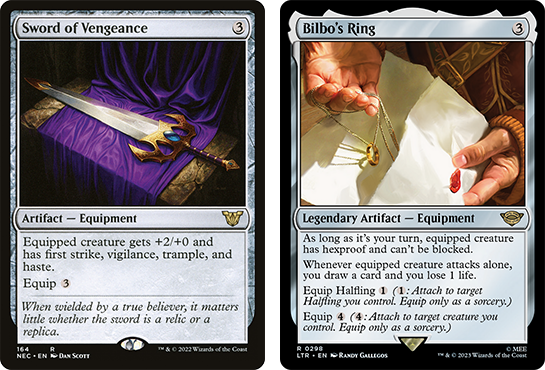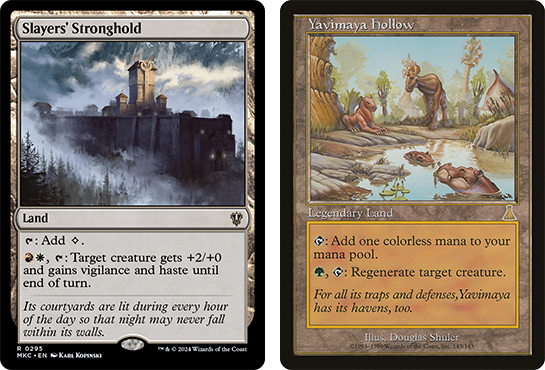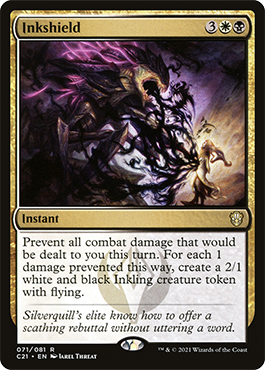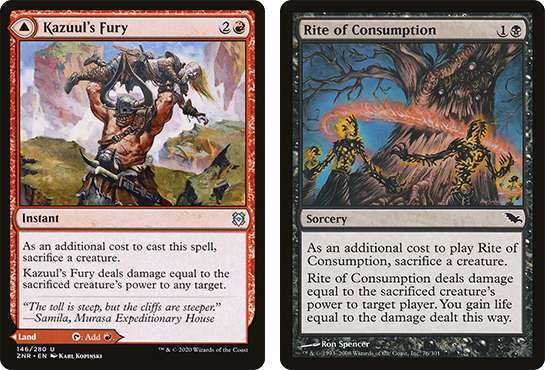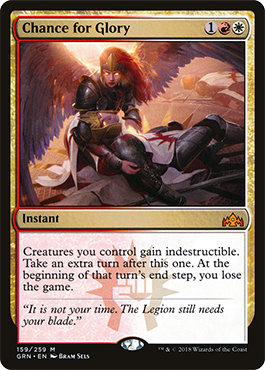Most Commander players build a Voltron deck at some point. Whether it’s equipment, auras, counters or a mix of the three, suiting up one large threat is a lot of fun. Winning with Voltron requires some skill-testing decision making, though. Here are five common mistakes Voltron players make on their path to victory.
So, you want to progress from lowly Squire to a true Warrior? It’s time to do your drills. Stop making these mistakes.
NOT HAVING A GAMEPLAN
The first mistake is often the one that separates good Voltron players from those out to just have a bit of fun: not having a gameplan. Every deck has a gameplan; it’s what you hope to achieve. For Voltron, on a basic level, your gameplan is to eliminate opponents with Commander damage or large increments of combat damage. The thing is, that’s only the plan at the most rudimentary level.
When you sit down in a pod, you also need to look at the decks you’re playing against. Generally speaking, the cards you play matter far less than the cards your opponents are playing. What are their win conditions? Do you need to race a combo deck? Is there a control deck that is unbeatable once set up? Is there a lifelink deck that will have to be Commander damaged out of the game?
Once you decide on that part of your gameplan, you also need to enact your deck’s gameplan. Most Voltron decks need some amount of setup to really get the snowball rolling downhill. You need to make mana, draw cards, and have key interaction (like protection spells) in order to keep that snowball moving unhindered.
There’s yet another level of gameplan beyond that, though, and that’s your active gameplan. In the early stages of a game, you need to decide who to attack and when. This is unique and organic, and changes every game, but some rough heuristics include attacking the player who is most likely to play blockers first, especially when they don’t have any; attacking the player most likely to have interaction when they’re tapped out, and if in doubt, pressuring a lifegain deck or deck that leverages its life total to draw cards or otherwise try and win.
NOT RUNNING ENOUGH TUTORS
While Voltron’s approach to games is anything but linear, Voltron’s gameplay can be, especially in the setup phase of the game. You want to reliably hit ramp and get a draw engine online, because you need to keep the snowball rolling at whatever cost.
If you’re in Enchantress, then this applies a little less; green has access to good ramp that doesn’t involve going to combat, and you can run the maximal number of enchantress effects to keep that hand topped up.
If you’re doing an Equipment version of Voltron though, you’ll want to pack tutors. Tutors get a bad rap in Commander, especially from those who see them as too linear and samey, and enabling the same win conditions every game. While I can agree with this when it comes to A+B combos, I think Voltron Equipment decks should absolutely be stacking their tutors, because without them, they can have a pretty miserable game. Not having Sword of the Animist, Sword of Hearth and Home or a treasure-generating equipment early game really slows a deck down.
Be sure to look at Inventors’ Fair in the manabase, plus the usual suspects: Stoneforge Mystic, Steelshaper’s Gift, Open the Armory and Kellan, the Fae-Blooded.
NOT PLAYING ENOUGH SUPPORT CREATURES
Speaking of support creatures, are you playing enough?
It’s tempting in Voltron to focus almost entirely on your Commander, but putting all of your eggs in one basket isn’t a good plan. Your Commander can be removed and taxed out for starters, or it could cost four or five or even six mana, meaning you need some early game bodies to get your engine moving.
What’s more, Casual Commander is very centered around attacking and dealing damage in order to accrue value, so if you don’t have any blockers – or your only one is your Vigilance Commander, easy to remove – then you’re going to take quite the beating.
Prioritizing creatures that synergize with your strategy is key. For equipment decks, that means the likes of Fervent Champion, or Bruenor Battlehammer, or cheap creatures with good evasion, like Selfless Spirit or Bladegraft Aspirant. You need to enable those attack and damage triggers yourself, so reducing your mana outlay and getting past blockers unimpeded is essential.
For enchantress decks, you are unlikely to block with your enchantresses unless you go-wide suiting them up. That’s why I’ve opted for cards like Hallowed Haunting and Sigil of the Empty Throne in my Sigarda deck, which make tokens to block with – or just attack with. While pillowfort helps you not lose, having a token army helps you win.
NOT VALUING KEYWORDS ENOUGH
Having good blockers and good attackers is key to surviving to the late game, but why is that, exactly? Well it’s a mixture of good evasiveness, and keeping your life total in a healthy range. Both of these things can also be achieved with keywords – something players don’t respect enough.
It’s easy to be distracted by all of the shiny Swords of X & Y, or legendary equipment like Blackblade Reforged, but the equipments that tend to do the most work for me are those like Sword of Vengeance, Shadowspear, and even Fleetfeather Sandals. You won’t get far without making your Voltron creature hard to block, and lifegain literally buys you extra turns when you’re playing Voltron, as you’ll be gaining 10+ life regularly.
As much as you can, put those effects into your manabase. Witch’s Clinic, Slayers’ Stronghold, Flamekin Village, Yavimaya Hollow, Plaza of Heroes… for every effect you’re outsourcing into the manabase, you’re getting redundancy for it, which is helping you fit in the cool splashy equipment that otherwise need your creature to already be evasive and survive to attack.
NOT RESPECTING FOGS
Surviving to attack is obviously the final part of a Voltron deck’s gameplan, and most Voltron players know to pack a Tamiyo’s Safekeeping, Blacksmith’s Skill or Slip Out the Back. Running these protection spells is one thing, but respecting the equal and opposite reaction to you enacting your gameplan is something different.
More than just annoying bounce spells or having your creature phased out, Fogs are the bane of existence for a Voltron player, especially if they come in the form of Inkshield or Selfless Squire; you might well be dead on the crackback.
One way to play around these effects is to run Fling effects; in red decks, Kazuul’s Fury is basically free to play. You can also try extra combats, which give you a way to overextend and eliminate an opponent you anticipate unpicking your board, while you have a window.
Ultimately, a lot of games will come down to picking your poison; with two players left to eliminate, you have to decide which is more likely to have the removal or win condition most likely to stop you untapping again. A well-placed fling or extra combat (or extra turn, if you’re blue!) can help you not even have to risk that decision in the first place.
END STEP
Voltron is a lot of fun in Commander, and one of my preferred strategies. It’s fragile, sure, but if you can learn from the tips I’ve shared today, you’ll be able to stride more confidently into your next matchup. Of all gameplay styles in Commander, Voltron is often the one that requires the most attention to how the tempo ebbs and flows in a game. Be sure to identify when there’s a weak link, and move in for the kill.
And if people get salty? Screw ‘em. Games gotta end.

Kristen is Card Kingdom’s Head Writer and a member of the Commander Format Panel. Formerly a competitive Pokémon TCG grinder, she has been playing Magic since Shadows Over Innistrad, which in her opinion, was a great set to start with. When she’s not taking names with Equipment and Aggro strategies in Commander, she loves to play any form of Limited.

